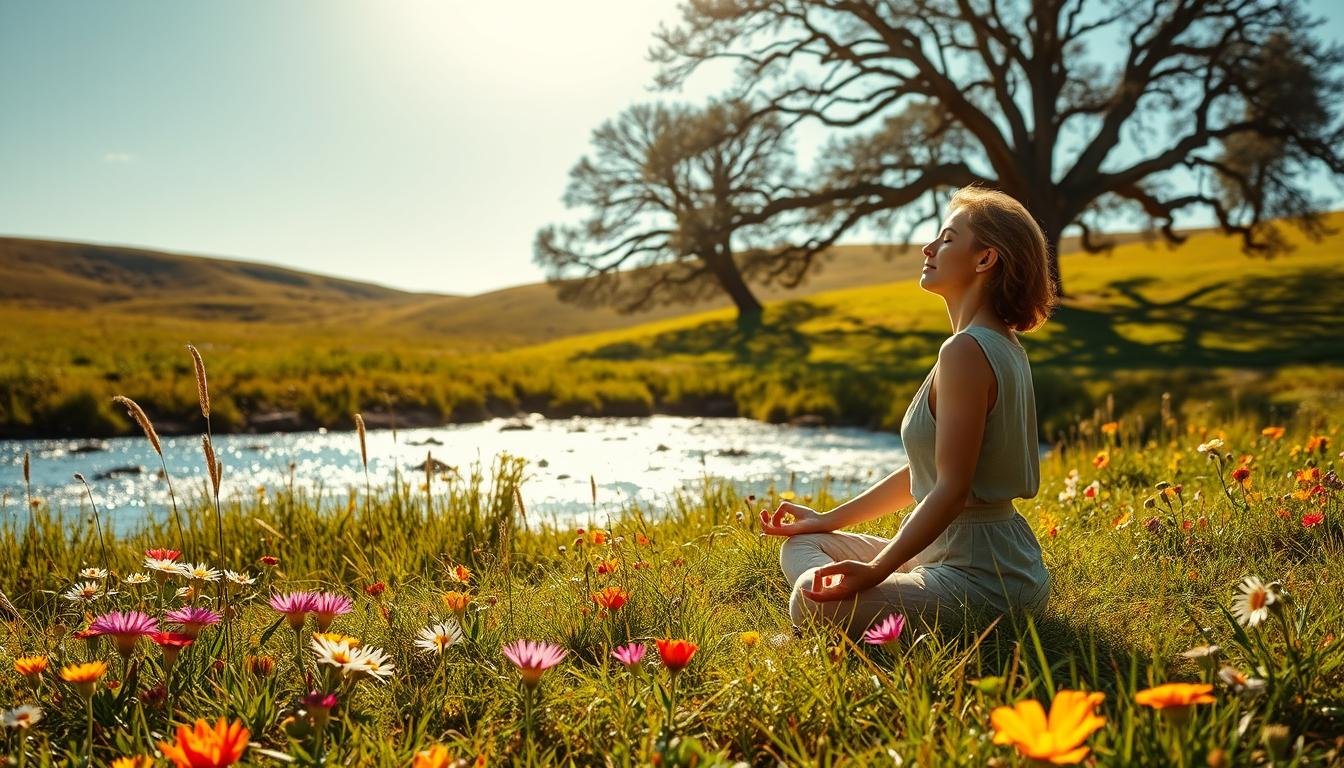Can spending time outside really improve our mental well-being? In today’s fast-paced world, stress and anxiety are common. Finding ways to keep our mental health good is key.
Studies show that being in nature can greatly benefit our minds. The idea of nature therapy is becoming more recognized. It can help with anxiety and depression, boost mood, and improve thinking skills.
When we explore the outdoors, we challenge ourselves physically and mentally. This break is essential for our minds. It shows how outdoor healing can help keep our mental wellness strong.
Key Takeaways
- Being outdoors can positively impact mental health.
- Nature therapy is a growing field with numerous benefits.
- Spending time outside can alleviate symptoms of anxiety and depression.
- Nature can improve mood and cognitive function.
- Engaging with the outdoors is a valuable tool for maintaining mental wellness.
Understanding Nature Therapy and Its Origins
More people are looking for new ways to boost their mental health. Nature therapy, also known as ecotherapy or green therapy, is becoming popular. It uses the natural world to help people feel better.
Definition of Nature Therapy
Nature therapy means spending time outdoors to improve both mental and physical health. It’s based on the idea that nature can make us feel better.
Key components of nature therapy include:
- Immersing oneself in natural environments
- Engaging in outdoor activities
- Fostering a connection with nature
Historical Context
Using nature for healing is not a new idea. Many cultures have seen the healing power of nature. For example, the Greeks and Romans believed in its benefits.
The modern idea of nature therapy started to grow in the late 20th century. This was because of studies showing how nature helps our minds.
| Period | Development in Nature Therapy |
|---|---|
| Ancient Times | Recognition of nature’s healing properties by various cultures |
| Late 20th Century | Emergence of modern nature therapy practices |
| Present Day | Increased recognition and practice of ecotherapy |
Key Concepts of Outdoor Healing
Outdoor healing is a big part of nature therapy. It includes the benefits of natural light, the calming sounds of nature, and how nature lowers stress.
The Science Behind Outdoor Healing
Nature’s healing powers are now widely accepted, thanks to solid research. This isn’t just a feeling; it’s based on science. It shows how nature helps our minds.
Psychological Mechanisms
Outdoor healing works through many psychological ways. One key idea is nature connection. This means feeling like you’re part of nature. Studies link a strong nature connection to better mental health, like less anxiety and depression.
Nature also helps us feel better by being a restorative environment. These places help us recover from stress and mental exhaustion. Natural spots are especially good at this, offering a break from city life’s constant noise and stress.
The Role of Nature in Stress Reduction
Nature is key in reducing stress, which is vital for our mental health. Research shows that being in nature lowers cortisol, heart rate, and blood pressure. These are signs of stress.
| Indicator | Urban Environment | Natural Environment |
|---|---|---|
| Cortisol Levels | Higher | Lower |
| Heart Rate | Elevated | Reduced |
| Blood Pressure | Higher | Lower |
The table shows how nature and cities affect stress. It highlights nature’s power to reduce stress. This supports healing in nature and boosts mental wellness.
Understanding how nature affects our minds helps us see the science behind outdoor healing. This knowledge supports nature therapy for mental health. It also encourages us to value and protect nature for our health.
Forest Bathing: The Japanese Practice Explained
Forest bathing is a Japanese tradition that involves spending time in the forest to improve well-being. It’s known as Shinrin-Yoku and has been around for decades. It’s now recognized worldwide for its health benefits.
What is Shinrin-Yoku?
Shinrin-Yoku, or forest bathing, is more than just walking in the woods. It’s about fully experiencing nature with all your senses. It helps people relax and feel calm by slowing down and breathing in the forest air.
Key elements of Shinrin-Yoku include:
- Slowing down and being present in nature
- Engaging all senses to experience the environment
- Breathing in the phytoncides released by trees, which have been shown to have health benefits
- Observing the natural beauty around, from flora to fauna
Benefits of Immersing in Forests
Forest bathing offers many health benefits. Some of these include:
- Reduced stress levels: Being in nature lowers cortisol, blood pressure, and heart rate.
- Improved mood: Forests can make you feel happier and reduce anxiety and depression.
- Enhanced immune function: Trees release phytoncides that boost the immune system.
Dr. Qing Li, a forest medicine expert, says, “Forest bathing is not just a walk. It’s a way to improve your health by connecting with nature.”
“Nature is not a place to visit. It’s home.” – Gary Snyder
By making forest bathing a part of your life, you can enjoy these benefits. It helps lead to a healthier and more balanced life.
Mental Wellness and the Natural World
Nature has always been a source of comfort and healing. It’s used in practices like ecotherapy. The bond between mental wellness and nature is deep and complex, touching on our minds, feelings, and bodies.
Connection Between Nature and Mental Health
Research shows that nature can boost our mental health. Being in nature calms us down, lowers stress, and lifts our mood. Nature therapy, or ecotherapy, uses these benefits in various ways.
Being outdoors can lower our stress hormones and heart rate. It also helps with anxiety and depression, making us feel better and think clearer.
Impact on Anxiety and Depression
Nature has a big impact on anxiety and depression. It offers a calm and healing space for those struggling. Forest bathing, from Japan, is a great example of how nature can help.
Here’s a table showing how different natural places affect our mental health:
| Environment | Impact on Anxiety | Impact on Depression |
|---|---|---|
| Forest | Reduced symptoms | Improved mood |
| Park | Lower stress levels | Enhanced cognitive function |
| Beach | Calming effect | Restorative |
In summary, nature is key to our mental health. By understanding how nature affects our minds, we can use it to improve our well-being.
Benefits of Spending Time Outdoors
Outdoor healing is becoming more popular. It shows how nature helps us feel better. Being outside can make us healthier in many ways.
Physical Health Benefits
Being outside is good for our bodies. It can make our hearts stronger, lower blood pressure, and boost our immune system. Activities like hiking, biking, or walking can help us stay fit and manage our weight.
Outdoor exercises are especially good for our health. They include guided activities that help us feel better physically and mentally.
Emotional Resilience Through Nature
Being outside also helps our minds. It can make us feel less anxious and depressed, and it improves our mood and thinking. Nature’s calmness helps us stay emotionally stable and resilient.
Green therapy uses nature to help our mental health. By doing outdoor activities, we can use green therapy to improve our mental well-being.
How to Start Your Nature Therapy Journey
The journey to mental wellness through nature therapy starts with a simple step: connecting with the outdoors. It’s important to think about how to add it to our daily lives.
Identifying Nearby Natural Spaces
The first step is to find natural spaces near you to visit often. These could be local parks, nature reserves, or even your backyard. The key is to find places that make you feel calm and connected to nature.
To get started, you can:
- Search online for parks or nature reserves in your area.
- Ask friends or family members for recommendations.
- Use apps or websites that help you discover nearby natural areas.

Creating Your Own Outdoor Rituals
Creating personal outdoor rituals can make your nature therapy experience better. This could be as simple as taking a short walk each morning, practicing yoga outdoors, or just sitting in a garden or park and watching the world go by.
Some ideas for outdoor rituals include:
| Ritual | Benefits |
|---|---|
| Morning Walks | Boosts energy and sets a positive tone for the day. |
| Meditation in Nature | Reduces stress and improves mental clarity. |
| Gardening | Provides a sense of accomplishment and connects you with the natural cycle. |
By adding these practices to your routine, you can deepen your connection with nature. This will enhance the benefits of nature therapy.
Engaging in Mindful Activities in Nature
Nature has a healing power. Doing mindful activities outside can make this effect stronger. By being mindful in nature, we improve our mental wellness and connect deeper with nature.
Hiking and Its Benefits
Hiking is a great way to exercise and connect with nature. It helps lower stress, boosts mood, and sharpens the mind. By paying attention to our surroundings, we can be fully present.
Hiking also boosts physical health, which is key for mental well-being. As we face challenges on trails, we grow stronger and more confident. This helps us feel better mentally.
Nature Journaling for Reflection
Nature journaling helps us slow down and notice the world around us. It’s about recording what we see, sketch, or note. This way, we appreciate nature more and think about our experiences.
This activity strengthens our nature connection and helps us process our feelings. Creating something in nature can be calming and clear our minds.
Trying nature-based interventions like hiking and journaling can greatly improve mental health. Adding these activities to our lives can bring many benefits of mindfulness in nature.
Seasonal Changes and Their Impact on Therapy
Nature therapy, or ecotherapy, is closely tied to nature’s cycles. It offers different healing landscapes with each season. The changing seasons can greatly affect our mental health and therapy experiences.
Spring and Renewal
Spring is a time of renewal and rebirth. It’s a powerful season for outdoor healing. The longer days and blooming plants can lift our mood and energy.
Engaging in green therapy in spring, like gardening, can tap into this renewal. It brings hope and rejuvenation.
Winter: Finding Peace in Stillness
Winter offers a unique therapeutic chance. Its quiet and stillness are perfect for reflection and introspection. Practicing ecotherapy in winter, like winter walks or snow mindfulness, can bring calm and clarity.
The changing seasons show the dynamic nature of outdoor healing. Each season brings its own benefits and opportunities for mental wellness. By embracing these changes, we can deepen our nature therapy practice and support our mental health journey.
Group Nature Activities for Healing
Being in nature with others can make us feel more connected and supported. This group approach to nature therapy boosts mental wellness. It creates a shared experience that helps everyone.
Nature-based group therapy is known for its mental health benefits. It helps people feel a sense of belonging and connection. These feelings are key to emotional healing.
Benefits of Nature-Based Group Therapy
Nature-based group therapy offers many advantages, including:
- Enhanced social connections and support networks
- Increased feelings of calm and reduced stress levels
- Improved mood and overall mental well-being
- Opportunities for shared experiences and communal reflection
A study in the Journal of Psychotherapy Research found that group nature therapy improves mental health.
“Being in nature together can facilitate deeper connections among group members, enhancing the therapeutic process.”
Examples of Outdoor Group Activities
Outdoor group activities can be diverse, from guided walks to yoga in the open. Here are a few examples:
| Activity | Description | Benefits |
|---|---|---|
| Guided Nature Walks | Led by a therapist or guide, these walks encourage mindfulness and connection with nature. | Reduces stress, promotes mindfulness |
| Outdoor Yoga | Yoga sessions conducted in outdoor settings, combining physical movement with natural surroundings. | Improves flexibility, reduces anxiety |
| Gardening Therapy | Group gardening activities that promote nurturing and growth. | Enhances mood, fosters a sense of accomplishment |
Participating in these activities helps individuals heal and builds a sense of community. As Richard Louv said, “Nature is not a place to visit. It’s home.” This highlights the value of nature in our healing practices.

Challenges of Accessing Natural Spaces
Urbanization has made it hard for people to connect with nature. This is a big problem as the world gets more urban. It’s tough to find places for outdoor healing, healing in nature, or green therapy.
Urban Barriers to Nature Engagement
Urban areas often don’t have easy-to-reach green spaces. This makes it hard for people to find places for nature therapy. The fast pace of city life and limited green areas discourage people from seeking nature.
Also, cities have more pollution. This makes natural spaces less appealing and harder to access for therapy.
Strategies for Overcoming Obstacles
There are ways to beat these challenges. One way is to find and use local parks or community gardens that might be hidden.
- Getting involved in community efforts to create or keep green spaces can help.
- Using online tools or apps to find nearby natural spots is helpful.
- Creating personal outdoor rituals, even in small areas like balconies or rooftops, can connect you with nature.
By using these strategies, people can start to overcome the hurdles to outdoor healing. They can bring healing in nature into their lives, even in cities.
The Role of Technology in Nature Therapy
Technology is helping us connect with nature in new ways. It’s changing how we enjoy and learn from the outdoors. This is good for our mental health.
Technology doesn’t replace nature but makes our outdoor experiences better. Ecotherapy uses digital tools to help us feel better through nature.
Apps and Resources for Outdoor Healing
There are many apps and websites for nature therapy. They offer guided walks, meditations, and lessons. These help us connect with nature more deeply.
- Guided nature walks and meditation apps
- Platforms for identifying local flora and fauna
- Online communities for sharing nature experiences
Apps like those that guide hikes and help identify wildlife make outdoor adventures better.
| Resource Type | Description | Benefits |
|---|---|---|
| Guided Meditation Apps | Offer calming, nature-themed meditations | Reduces stress, improves mental clarity |
| Nature Identification Apps | Help identify plants, animals, and landscapes | Enhances nature connection, encourages exploration |
| Online Nature Communities | Platforms for sharing experiences and advice | Fosters community, supports mental wellness |
Balancing Tech Use with Nature Immersion
Technology can make nature better, but we must not overdo it. Too much tech can lessen the benefits of being outside.
To find a good balance, set times when you won’t use devices outdoors. This way, you can enjoy nature more fully.
Using technology wisely in nature therapy can improve our connection with nature. It’s important to use it to support, not replace, our time in nature.
Conclusion: Embracing Nature for Mental Wellness
Nature therapy is a powerful tool for better mental health. It lets people connect with nature, which boosts their well-being.
Key Takeaways
Forest bathing reduces stress and improves well-being. Activities like hiking and nature journaling help build emotional strength. They also deepen our connection with nature.
Embracing Outdoor Healing
Adding nature therapy to daily life helps keep mental health strong. Solo or group activities in nature offer benefits to all. We suggest exploring nearby nature spots and starting your own nature therapy journey. Nature’s healing power can greatly improve mental wellness.



